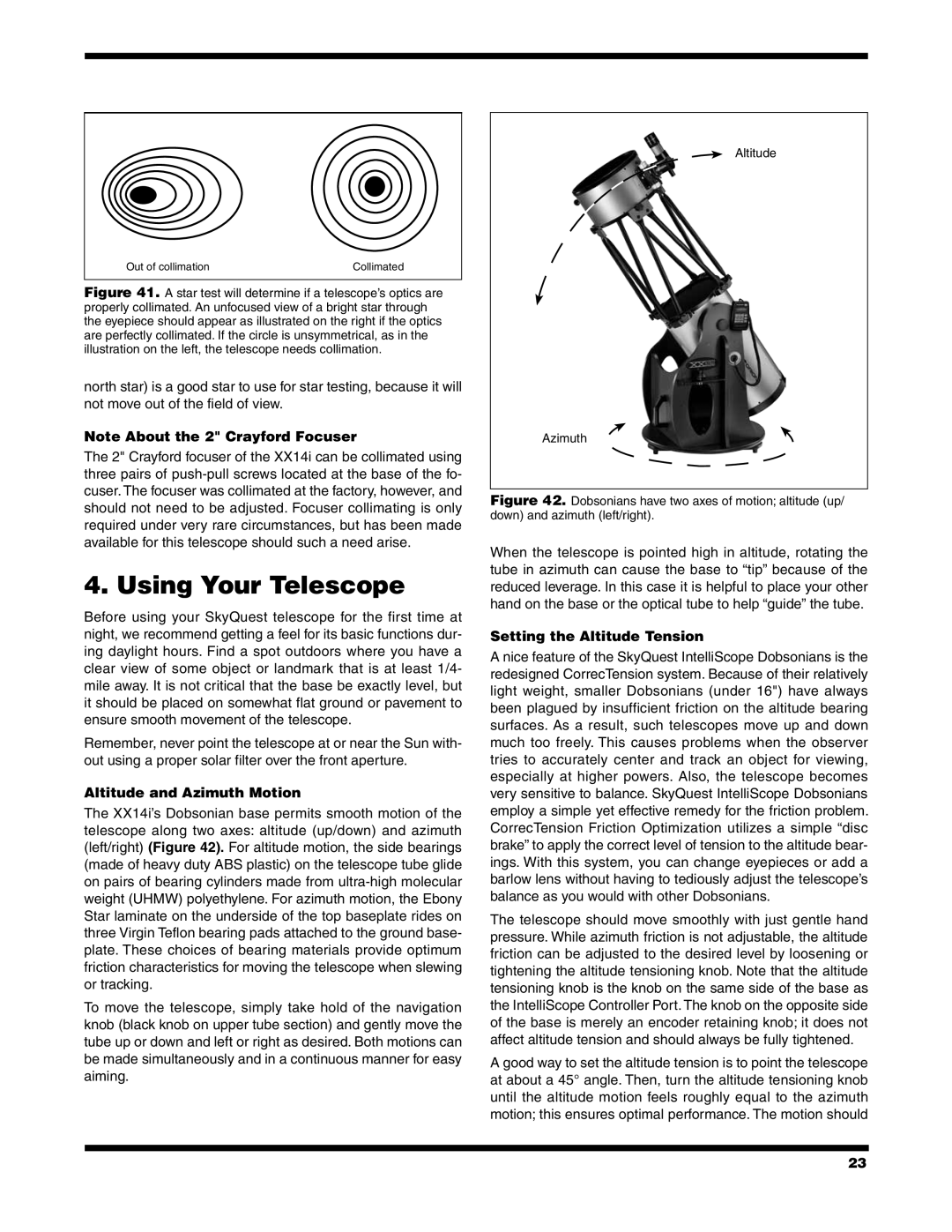
Out of collimation | Collimated |
Figure 41. A star test will determine if a telescope’s optics are properly collimated. An unfocused view of a bright star through the eyepiece should appear as illustrated on the right if the optics are perfectly collimated. If the circle is unsymmetrical, as in the illustration on the left, the telescope needs collimation.
north star) is a good star to use for star testing, because it will not move out of the field of view.
Note About the 2" Crayford Focuser
The 2" Crayford focuser of the XX14i can be collimated using three pairs of
4. Using Your Telescope
Before using your SkyQuest telescope for the first time at night, we recommend getting a feel for its basic functions dur- ing daylight hours. Find a spot outdoors where you have a clear view of some object or landmark that is at least 1/4- mile away. It is not critical that the base be exactly level, but it should be placed on somewhat flat ground or pavement to ensure smooth movement of the telescope.
Remember, never point the telescope at or near the Sun with- out using a proper solar filter over the front aperture.
Altitude and Azimuth Motion
The XX14i’s Dobsonian base permits smooth motion of the telescope along two axes: altitude (up/down) and azimuth (left/right) (Figure 42). For altitude motion, the side bearings (made of heavy duty ABS plastic) on the telescope tube glide on pairs of bearing cylinders made from
To move the telescope, simply take hold of the navigation knob (black knob on upper tube section) and gently move the tube up or down and left or right as desired. Both motions can be made simultaneously and in a continuous manner for easy aiming.
Altitude
Azimuth
Figure 42. Dobsonians have two axes of motion; altitude (up/ down) and azimuth (left/right).
When the telescope is pointed high in altitude, rotating the tube in azimuth can cause the base to “tip” because of the reduced leverage. In this case it is helpful to place your other hand on the base or the optical tube to help “guide” the tube.
Setting the Altitude Tension
A nice feature of the SkyQuest IntelliScope Dobsonians is the redesigned CorrecTension system. Because of their relatively light weight, smaller Dobsonians (under 16") have always been plagued by insufficient friction on the altitude bearing surfaces. As a result, such telescopes move up and down much too freely. This causes problems when the observer tries to accurately center and track an object for viewing, especially at higher powers. Also, the telescope becomes very sensitive to balance. SkyQuest IntelliScope Dobsonians employ a simple yet effective remedy for the friction problem. CorrecTension Friction Optimization utilizes a simple “disc brake” to apply the correct level of tension to the altitude bear- ings. With this system, you can change eyepieces or add a barlow lens without having to tediously adjust the telescope’s balance as you would with other Dobsonians.
The telescope should move smoothly with just gentle hand pressure. While azimuth friction is not adjustable, the altitude friction can be adjusted to the desired level by loosening or tightening the altitude tensioning knob. Note that the altitude tensioning knob is the knob on the same side of the base as the IntelliScope Controller Port. The knob on the opposite side of the base is merely an encoder retaining knob; it does not affect altitude tension and should always be fully tightened.
A good way to set the altitude tension is to point the telescope at about a 45° angle. Then, turn the altitude tensioning knob until the altitude motion feels roughly equal to the azimuth motion; this ensures optimal performance. The motion should
23
